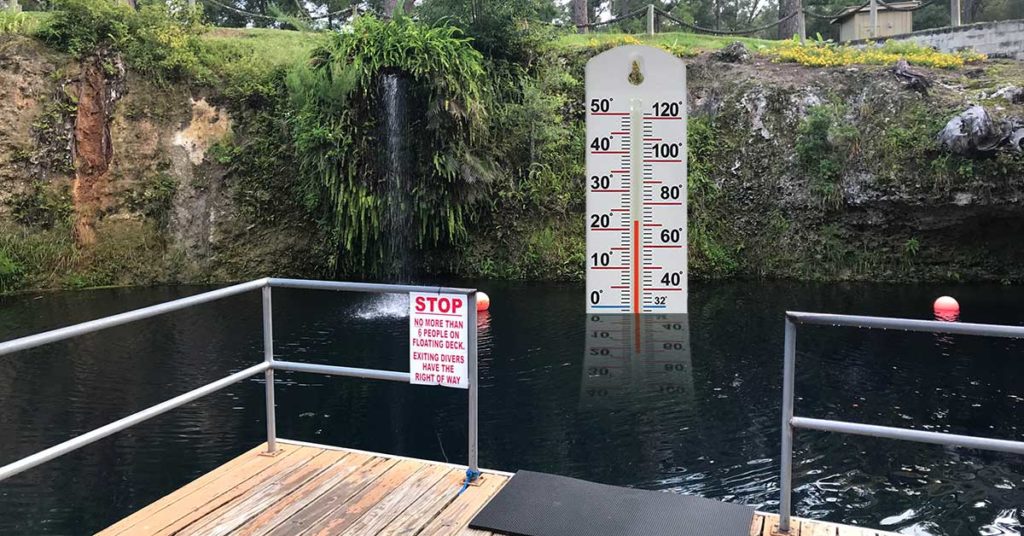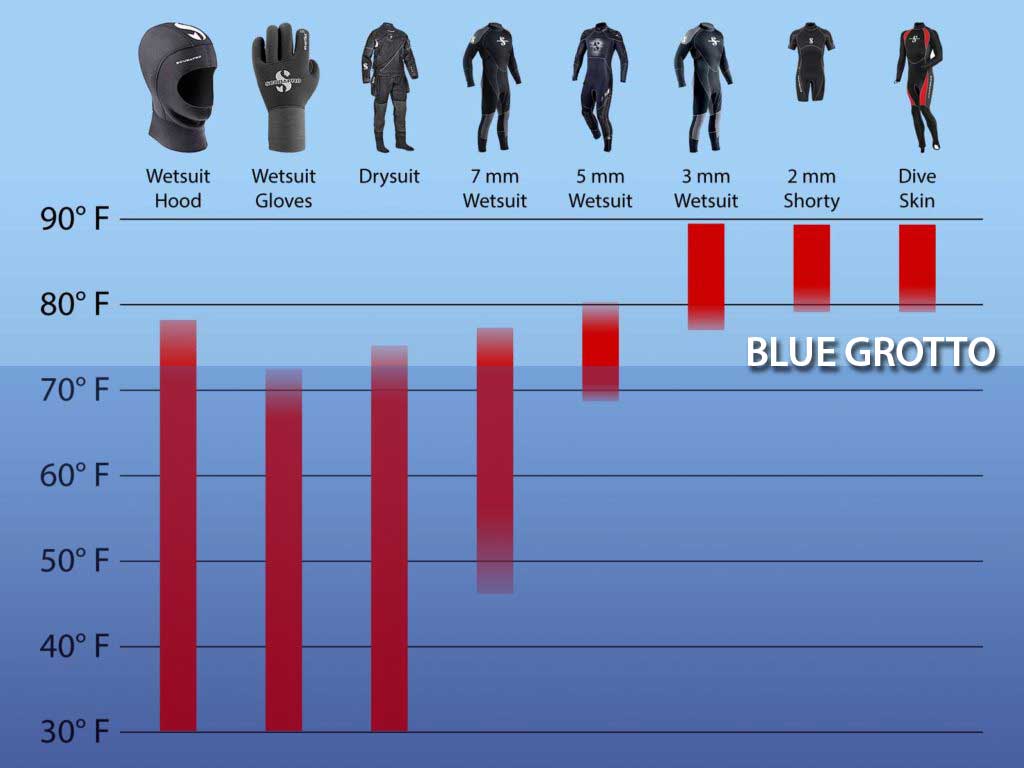Warm divers are happy divers. Bringing the right suit to the Grotto means you can focus on all the cool stuff you are seeing and not on how cold and miserable you are. You are also safer because you are not being distracted by the cold. But what exactly is the right suit?
Let’s cut to the chase
Here is the short version:
If you are like most divers, to truly enjoy the Grotto, you must wear a minimum of a full-length, 5mm wetsuit.
You can up that to a 7mm or even a drysuit and be even warmer. However, unless you overdo it on drysuit undergarments, it is unlikely you will ever be too warm.
This is all you really need to know. However, if we have piqued your curiosity, we have a lot more to share on the subject of staying warm.
Exactly how cold is the Grotto?
If you have watched the Blue Grotto orientation video (mandatory viewing for anyone diving the Grotto), you already know the water is a constant 22° C/72° F year-round. And, because the steady flow of water constantly mixes the water from top to bottom, there are no thermoclines. You will find the temperature to be the same at depth as it is at the surface.
So room temperature…right? Not quite.
In the USA, most folks consider 22° C/72° F to be “room temperature.” This being the case, divers in the Grotto shouldn’t need any thermal protection…right? Well, not quite.
If you think back to your beginning scuba course, you will remember that water conducts heat away from your body 25 times faster than air does. So, in other words, being in 22° C/72° F water in just a swimsuit is like running around in 4.5° C/40° F air in just your underwear. You won’t be happy for very long.
Exposure protection and water temperature
Interestingly enough, no matter how much or how little you wear in terms of exposure protection, your initial reaction upon entering the water will be largely the same.
- There will be that initial shock but, within a few seconds, your body will acclimate to the cold (i.e., “gets used to it”).
- At this point, you will most likely not be utterly miserable. Even if wearing just a swimsuit, you may be okay for up to ten minutes or more.
- The difference wetsuits and drysuits make is in how long after that your remain comfortable. You want to ensure you remain comfortable for at least 40 minutes or more.
It is important to understand that neither wetsuits nor drysuits “make” you warm. All they do is retard heat loss. The more effective they are, the longer you will remain comfortable.
The chart below depicts what most experienced divers consider to be adequate exposure protection for water of different temperatures. Over this, we have superimposed a line representing the Grotto’s 22° C/72° F water.
One thing you should notice immediately is that 3mm wetsuits, dive skins and shorties are best suited for water above 26° C/80° F. Keep that in mind when deciding what suit to bring with you.
Drysuits in Florida?
During the week, it’s not unusual to see the Grotto populated by students in technical and rebreather courses. Most of them will be in drysuits.
This often comes as a shock to visiting divers who are unfamiliar with the springs. We’ve heard more than one visitor look at a drysuited diver and go, “Oh my God. Just how cold is that water?”
Understand that the decision to dive dry has less to do with water temperature and more to do with factors such as depth and length of exposure.
- Most cave and technical diving take place at depths of up to 30 m/100 ft or more. At these depths, even the thickest wetsuits become paper-thin and provide little in the way of thermal protection.
- The typical cave or tech dive can last up to an hour or more. It’s usually followed by several minutes or more of decompression, during which divers will be remaining still. This means they will not be generating the same amount of body heat as they do while swimming and can become chilled faster.
- Finally, as drysuits are standard gear for cave and tech diving in Florida, most divers who pursue these activities have their gear configured for drysuit diving. They find it too much of a hassle to constantly switch back and forth.
Interestingly enough, unless you go overboard on how much you wear in the way of undergarments, you are not likely to overheat in a drysuit when diving the springs. In fact, you will most likely be one of the most comfortable divers in the water.
Don’t forget air temperature
When deciding what to bring with you to the Gotto and how to use it, there is more to consider than just water temperature. You must also factor in air temperature.
- During warmer months, the last thing you want to do is stand around for any length of time in a dry wetsuit. Doing so can make you dangerously overheated. You are better off assembling all of your other gear first so that, as soon as you don your wetsuit, you can quickly put on the rest of your gear and enter the water.
- Conversely, during the winter, when Fahrenheit air temperatures are often in the 40s and 50s, donning a dry wetsuit can help keep you warm before you enter the water.
What’s of greatest concern during the winter is what happens just after and between dives.
- If you stand around in a wet wetsuit, you can become dangerously chilled very quickly.
- If planning subsequent dives, it’s important to not allow your core temperature to drop. Doing so means you will get cold faster when you re-enter the water.
What strategies can you follow to accomplish this?
- If done diving for the day, get out of your wetsuit and into warm clothes as quickly as possible. You may want to peel out of your wetsuit while standing in one of the warm showers you’ll find both inside and outside the bathhouse.
- If you are going to be out of the water for any length of time between dives, get out of your wetsuit as well. Yes, we know, the thought of having to get into a cold, slimy wetsuit is not that appealing. But there is a workaround: Re-don your suit while standing in a warm shower. The suit will go on easier and will be filled with warm water when you are done. Do this, then head for the water as quickly as possible.
- If you need to stand around in a wet wetsuit, consider getting a dive parka. This is an oversized overcoat designed to be worn over a wet wetsuit. It can significantly cut heat loss.
Ironically, this is another advantage drysuit divers have over wetsuit divers. When they get out of the water, they are already dry on the inside. Standing around in a drysuit between dives is no big deal.
We have you covered
So, what if you do not currently own a wetsuit? Or the suit you own isn’t thick enough or no longer fits? No problem.
We recently replaced our rental wetsuits with brand-new ones. They are all 5mm thick and an absolute joy to wear. So, if you don’t currently have the right suit, just rent one of ours.



